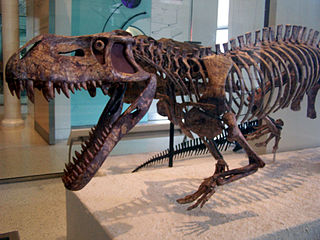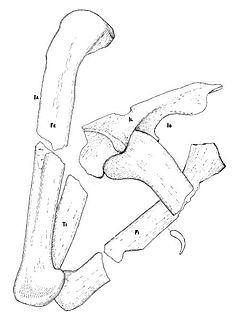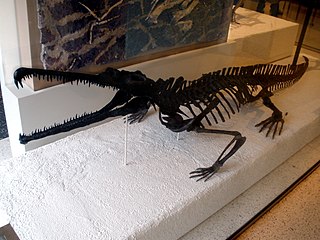
Archosauria is a clade of diapsids, with birds and crocodilians as the only living representatives. Archosaurs are broadly classified as reptiles, in the cladistic sense of term which includes birds. Extinct archosaurs include non-avian dinosaurs, pterosaurs, and extinct relatives of crocodilians. Modern paleontologists define Archosauria as a crown group that includes the most recent common ancestor of living birds and crocodilians, and all of its descendants. The base of Archosauria splits into two clades: Pseudosuchia, which includes crocodilians and their extinct relatives, and Avemetatarsalia, which includes birds and their extinct relatives.

Crurotarsi is a group of archosauriform reptiles that includes the archosaurs and the extinct, crocodile-like phytosaurs. Prior to 2011, the name had instead been used to refer to archosaurs closer to crocodilians than to birds and other dinosaurs. Another common term for croc-line archosaurs is Pseudosuchia. The pre-2011 definition of Crurotarsi assumed that phytosaurs were closer to crocodilians than to birds. However, a 2011 study argued that phytosaurs were not crown-archosaurs. Crurotarsi was redefined to pertain to a larger group which included Phytosauria and Archosauria.

Phytosaurs are an extinct group of large, mostly semiaquatic Late Triassic archosauriform reptiles. Phytosaurs belong to the family Phytosauridae and the order Phytosauria. Phytosauria and Phytosauridae are often considered to be equivalent groupings containing the same species, but some studies have identified non-phytosaurid phytosaurians. Phytosaurs were long-snouted and heavily armoured, bearing a remarkable resemblance to modern crocodilians in size, appearance, and lifestyle, as an example of convergence or parallel evolution. The name "phytosaur" means "plant reptile", as the first fossils of phytosaurs were mistakenly thought to belong to plant eaters. The name is misleading because the sharp teeth in phytosaur jaws clearly show that they were predators.

Euparkeria is an extinct genus of archosauriform from the Middle Triassic of South Africa. It was a small reptile that lived between 245-230 million years ago, and was close to the ancestry of Archosauria, the group that includes dinosaurs, pterosaurs, and modern birds and crocodilians.

Pseudosuchia is one of two major divisions of Archosauria, including living crocodilians and all archosaurs more closely related to crocodilians than to birds. Pseudosuchians are also informally known as "crocodilian-line archosaurs". Prior to 2011, the clade Pseudosuchia was often called Crurotarsi in reference to the crurotarsal ankle found in almost all members of the group, which traditionally included phytosaurs, ornithosuchids, and suchians. However, a major 2011 study of Triassic archosaur relations proposed that phytosaurs were not closely related to other traditional "crurotarsans", at least compared to "bird-line archosaurs" (Avemetatarsalians) such as pterosaurs and dinosaurs. As a result, the possession of a crurotarsal ankle was considered a plesiomorphic ("primitive") feature retained by pseudosuchians. Crurotarsi now refers to a broader group of reptiles including Pseudosuchia, Phytosauria, and Avemetatarsalia. Despite Pseudosuchia meaning "false crocodiles", the name is a misnomer as true crocodilians are a subset of the group.
Suchoprion is a dubious genus of phytosaurian archosaur known from poor remains from the Late Triassic of North America. It was once thought to be a theropod dinosaur until 2013, when it was reclassified as a phytosaur.

Prestosuchidae was a polyphyletic grouping of carnivorous archosaurs that lived during the Triassic. They were large active terrestrial apex predators, ranging from around 2.5 to 7 metres in length. They succeeded the Erythrosuchidae as the largest archosaurs of their time. While resembling erythrosuchids in size and some features of the skull and skeleton, they were more advanced in their erect posture and crocodile-like ankle, indicating more efficient gait. "Prestosuchids" flourished throughout the whole of the middle, and the early part of the late Triassic, and fossils are so far known from Europe, India, Africa (Tanzania), Argentina, and Paleorrota in Brazil. However, for a long time experts disagree regarding the phylogenetic relationships of the group, what genera should be included, and whether indeed the "Prestosuchidae" constitute a distinct family.

Poposaurus is an extinct genus of pseudosuchian archosaur from the Late Triassic of the southwestern United States. It belongs to the clade Poposauroidea, an unusual group of Triassic pseudosuchians that includes sail-backed, beaked, and aquatic forms. Fossils have been found in Wyoming, Utah, Arizona, and Texas. Except for the skull, most parts of the skeleton are known. The type species, P. gracilis, was described by M. G. Mehl in 1915. A second species, P. langstoni, was originally the type species of the genus Lythrosuchus. Since it was first described, Poposaurus has been variously classified as a dinosaur, a phytosaur, and a "rauisuchian".
Palaeoctonus is an extinct genus of archosaur known only from isolated teeth. The name is derived from Greek. The genus is believed to have flourished during the Upper (Late) Triassic period.

Rutiodon is an extinct genus of archosaur belonging to the family Phytosauridae. It lived during the Late Triassic period, and was about 3 to 8 meters in length. Rutiodon is known from the eastern United States.

Nicrosaurus (/nɛkroʊˈsɔrəs/) is an extinct genus of phytosaur reptile existing during the Late Triassic period. Although it looked like a crocodile, it was not closely related to these creatures, instead being an example of parallel evolution. The main difference between Nicrosaurus and modern crocodiles is the position of the nostrils – Nicrosaurus's nostrils, or external nares, were placed directly in front of the forehead, whereas in crocodiles, the nostrils are positioned on the end of the snout. A 2013 study has also found that illium of Nicrosaurus is quite distinctive from all other phytosaurs.
Dongusuchus is an extinct genus of archosauriform. Fossils have been found from the Donguz Formation outcropping on the banks of the Donguz River in the Orenburg Oblast of Russia. They are associated with a fossil assemblage called the Eryosuchus Fauna, named after the capitosaurid Eryosuchus, the most common organism found from the assemblage. The locality dates back to the Anisian and early Ladinian stages of the Middle Triassic.

Heptasuchus is an extinct genus of loricatan pseudosuchian known from the Middle or Late Triassic upper Chugwater Group of Wyoming, United States. It contains a single species, Heptasuchus clarki, the first formally recognized "rauisuchian" or loricatan pseudosuchian from North America.
Tarjadia is an extinct genus of erpetosuchid pseudosuchian, distantly related to modern crocodilians. It is known from a single species, T. ruthae, first described in 1998 from the Middle Triassic Chañares Formation in Argentina. Partial remains have been found from deposits that are Anisian-Ladinian in age. Long known mostly from osteoderms, vertebrae, and fragments of the skull, specimens described in 2017 provided much more anatomical details and showed that it was a fairly large predator. Tarjadia predates known species of aetosaurs and phytosaurs, two Late Triassic groups of crurotarsans with heavy plating, making it one of the first heavily armored archosaurs. Prior to 2017, most studies placed it outside Archosauria as a member of Doswelliidae, a family of heavily armored and crocodile-like archosauriforms. The 2017 specimens instead show that it belonged to the Erpetosuchidae.

Suchia is a clade of archosaurs containing the majority of pseudosuchians. It was defined as the least inclusive clade containing Aetosaurus ferratus, Rauisuchus tiradentes, Prestosuchus chiniquensis, and Crocodylus niloticus by Nesbitt (2011). Generally the only pseudosuchian group which is omitted from Suchia is the family Ornithosuchidae, although at least one analysis classifies ornithosuchids as close relatives of erpetosuchids and aetosaurs. Phytosaurs are also excluded from Suchia, although it is unclear whether they qualify as pseudosuchians in the first place.

Diandongosuchus is an extinct genus of archosauriform reptile, possibly a member of the Phytosauria, known from the Middle Triassic of China. The type species Diandongosuchus fuyuanensis was named in 2012 from the Falang Formation of Yunnan Province. It is a marine species that shows similarities with another Chinese Triassic species called Qianosuchus mixtus, although it has fewer adaptations toward marine life. It was originally classified as the basal-most member of the pseudosuchian clade Poposauroidea. However, a subsequent study conducted by Stocker et al. indicated it to be the basalmost known phytosaur instead.

Chirotherium, also known as Cheirotherium (‘hand-beast’), is a Triassic trace fossil consisting of five-fingered (pentadactyle) footprints and whole tracks. These look, by coincidence, remarkably like the hands of apes and bears, with the outermost toe having evolved to extend out to the side like a thumb, although probably only functioning to provide a firmer grip in mud. Chirotherium tracks were first found in 1834 in Lower Triassic sandstone (Buntsandstein) in Thuringia, Germany, dating from about 243 million years ago (mya).
Wannia is an extinct genus of basal phytosaur reptile known from the Late Triassic of Texas, southern United States. It contains a single species, Wannia scurriensis, which is known from a single specimen. This species was originally named as a species referred to Paleorhinus and later was considered as a possible junior synonym of Paleorhinus bransoni. However its re-description revealed five autapomorphies, and a phylogenetic position as the most basal known phytosaur, justifying the erection of a new generic name for the species.
Nundasuchus is an extinct genus of crurotarsan, possibly a suchian archosaur related to Paracrocodylomorpha. Remains of this genus are known from the Middle Triassic Manda beds of southwestern Tanzania. It contains a single species, Nundasuchus songeaensis, known from a single partially complete skeleton, including vertebrae, limb elements, osteoderms, and skull fragments.

Vivaron is a genus of rauisuchid known from the Late Triassic Chinle Formation in New Mexico. It is the second rauisuchid known from the southwestern United States, and it highlights the wide biogeographic range similar rauisuchid taxa occupied during the Late Triassic across Pangaea, despite the varied faunal assemblages at different latitudes.













